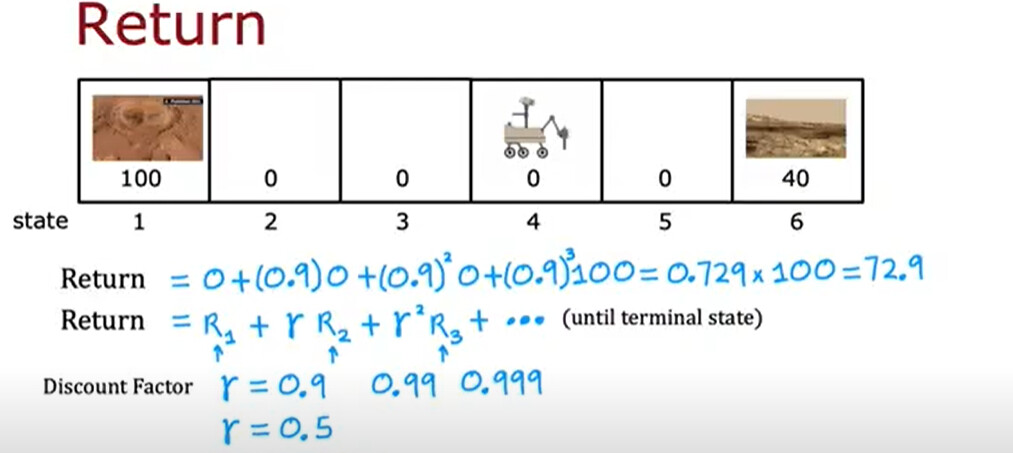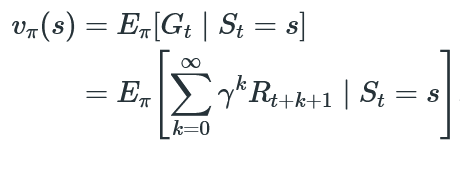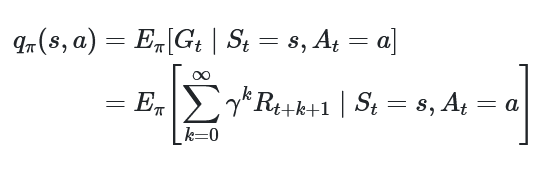Reinforcement Learning Concepts
Reinforcement Learning Concepts
What is Reinforcement Learning?

- Learning from interaction with the environment.
- Agent observes the environment and takes actions on it.
- The environment provides feedback in the form of rewards.
The agent learns to maximize the cumulative reward over time.Episodic vs Continuing Tasks
- Episodic Tasks: The task has a clear beginning and end.
tic-tac-toeis an example of an episodic task. - Continuing Tasks: The task does not have a clear end.
stock tradingis an example of a continuing task.
Discount factor
- If the agent’s aim is to maximize the cumulative reward, for continuing tasks, the total reward can be infinite.
- To avoid this, we use a discount factor
γ(gamma) to reduce the value of future rewards. - The discount factor is a number between 0 and 1.
- This bounds the total reward to a finite value.

- Higher gamma means the agent will consider future rewards more.
- Lower gamma means the agent will consider immediate rewards more.
- The discount factor is a hyperparameter that can be tuned based on the task.Terminology
- Agent: The learner or decision maker.
- Environment: The external system that the agent interacts with.
- State: A representation of the environment at a given time.
- Observation: The information the agent receives from the environment.
- Action: The set of all possible actions the agent can take.
- Policy: A strategy that the agent employs to determine the next action based on the current state.
- Reward: A
scalarfeedback signal received from the environment after taking an action.
🚫
Remember: Observation won’t always be equal to state. For example, a robot may only see what’s in front of it, but the state may include the entire environment.
Value Functions
A function that estimates the expected return (cumulative reward) from a given state or action.
State-Value Function (V)

- The expected return from a state
sunder a policy $\pi$. - It’s like, if I reach state
s, and then I follow the policy $\pi$, what’s the maximum reward I can get?
Action-Value Function (Q)

- The expected return from a state
sand actionaunder a policy $\pi$. - Think of it like, if I reach state
sand there I take actiona, and after that I follow the policy $\pi$, what’s the maximum reward I can get?
But what exactly is state-value & action-value function?
First, let’s understand: What is policy?
- A policy is like strict parents, they tell you what to do in which situation.
- If it’s 9 PM, don’t use your phone, If it’s 10 PM, go to bed.
- So, a policy is a mapping from state to action.
- A policy can be deterministic or stochastic.
- A deterministic policy is like: when in state
s, do actiona. - A stochastic policy is like: when in state
s, do actionawith probabilityp, and actionbwith probabilityq. (p + q <= 1)
Now, let’s understand: What is state-value function?
- The state-value function is like: your newbie trader friend telling you, if you somehow just start trading, you will make $100000 in 1 month.
- So, it’s like, if you reach state
s, and follow the policy $\pi$ (his instagram course-seller guru), you will get $1000 in 1 month. - It says nothing about the action you take, just the state you are in.
So, it’s like a mapping from state to expected return.
Now: What is action-value function?
- Now, your friend tells you, if you start trading and buy
AAPLstock, and after that you follow his instagram course-seller guru, you will make $100000 in 1 month. - So, it’s like, if you reach state
s, and take actiona, and after that you follow the policy $\pi$ (his instagram course-seller guru), you will make $100000 in 1 month.
- Here, We also consider the action that you need to take after reaching the state.
- So, it's like a mapping from state-action pair to expected return.- If you reach stanford, you can become a millionaire. (state-value function)
- If you reach stanford and do a cs degree, you can become a millionaire. (action-value function)Markov Decision Process (MDP)
- If I’ve complete details of the current state, I can predict the just next state. I don’t need to know the previous states.
- Anything that satisfies the Markov property is called a Markov process.
- And, we can we make something satisfy the Markov property by adding some extra information to the state.
Bellman Equation

- max value of the immediate reward for all possible actions + value of the next state.
- expected value of the immediate reward + expected value of the next state.What’s Next?
Enough concepts, now let’s play with Q-Learning and Deep Q-Learning.
Check out the Q-Learning and Deep Q-Learning blogs to learn more about these algorithms.
Last updated on
